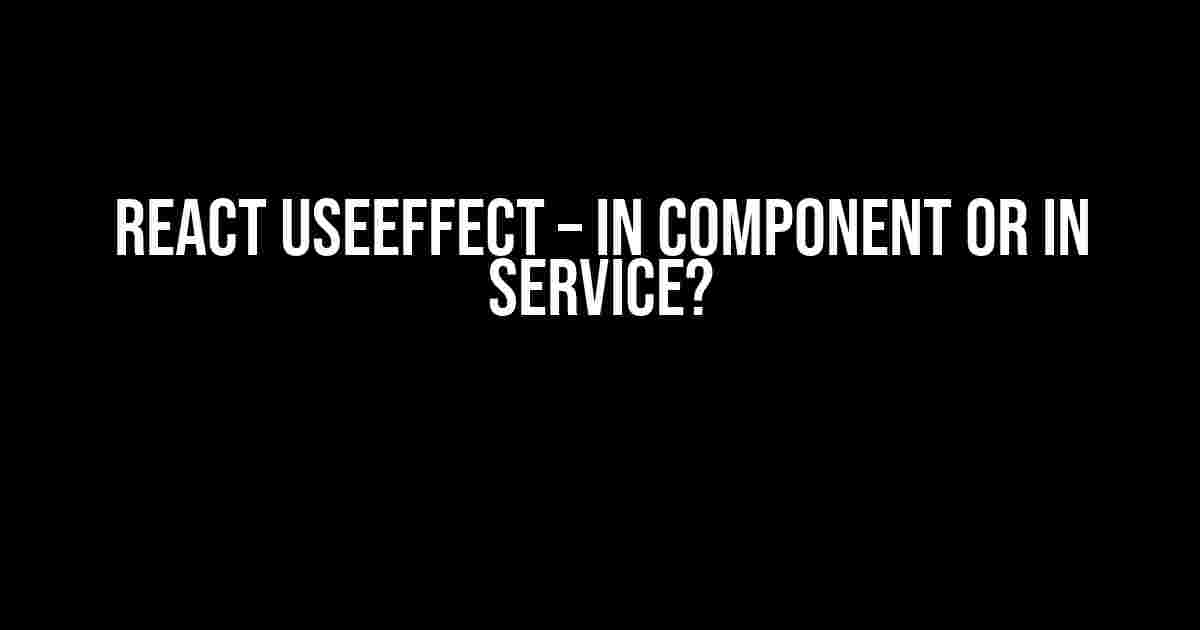When it comes to using React’s useEffect hook, one of the most common questions that arise is where to place it – in the component or in a service. In this article, we’ll dive deep into the world of useEffect and explore the pros and cons of each approach, providing clear and direct instructions to help you make an informed decision.
The Basics of useEffect
Before we dive into the main topic, let’s quickly review what useEffect is and how it works. useEffect is a hook that allows you to run some code after rendering, it’s a way to handle side-effects in functional components. It takes two arguments: a function to run, and an array of dependencies.
import { useState, useEffect } from 'react';
function Example() {
const [count, setCount] = useState(0);
useEffect(() => {
// this code will run after the component has mounted
document.title = `You clicked ${count} times`;
}, [count]);
return (
You clicked {count} times
);
}In Component – The Pros
One of the most common places to put useEffect is directly in the component that needs it. This approach has several advantages:
- Easier to understand: When the useEffect hook is placed directly in the component, it’s clear what it’s doing and why. This makes it easier for other developers (or your future self) to understand the code.
- Tighter coupling: By placing useEffect in the component, you’re implicitly stating that this effect is tightly coupled to this specific component. This can make it easier to reason about the code and avoid unnecessary complexity.
- Faster development: When you’re building a new component, it’s often easier to just add the useEffect hook directly to the component rather than creating a separate service.
In Component – The Cons
While placing useEffect directly in the component can be convenient, it’s not without its drawbacks:
- Tight coupling: While tight coupling can be a benefit, it can also make it harder to reuse the effect in other components. If you find yourself needing the same effect in multiple components, you’ll end up duplicating code.
- Complexity: As your component grows in complexity, so does the useEffect hook. This can make the component harder to understand and maintain.
In Service – The Pros
Another approach is to extract the useEffect hook into a separate service. This has several benefits:
- Reusability: By extracting the effect into a separate service, you can reuse it in multiple components without duplicating code.
- Decoupling: Services are often designed to be decoupled from specific components, making it easier to change or replace them without affecting the rest of the application.
- Easier testing: Services are typically easier to test than components, making it easier to ensure the effect is working correctly.
In Service – The Cons
While extracting useEffect into a service can be beneficial, it’s not without its drawbacks:
- Added complexity: Creating a separate service adds complexity to your application, which can make it harder to understand and maintain.
- Over-engineering: If you’re only using the effect in a single component, creating a separate service might be overkill.
When to Use Each Approach
So, when should you use each approach? Here are some general guidelines:
| Scenario | In Component | In Service |
|---|---|---|
| Simple effect used in a single component | ✔️ | ❌ |
| Complex effect used in multiple components | ❌ | ✔️ |
| Effect requires tight coupling to the component | ✔️ | ❌ |
| Effect can be reused across the application | ❌ | ✔️ |
Best Practices
Regardless of whether you choose to place useEffect in the component or in a service, here are some best practices to keep in mind:
- Keep it simple: Try to keep your useEffect hooks as simple as possible. Avoid complex logic or multiple side-effects in a single hook.
- Use a clear and concise naming convention: Use a clear and concise naming convention for your useEffect hooks, such as `useFetchData` or `useInterval`.
- Document your useEffect hooks: Take the time to document your useEffect hooks, explaining what they do and why they’re necessary.
- Test your useEffect hooks: Make sure to thoroughly test your useEffect hooks to ensure they’re working as expected.
Conclusion
In conclusion, the decision to place React’s useEffect hook in the component or in a service depends on the specific needs of your application. By considering the pros and cons of each approach and following best practices, you can ensure that your useEffect hooks are easy to understand, maintain, and reuse.
Remember, there’s no one-size-fits-all solution when it comes to useEffect. Take the time to evaluate the specific needs of your application and make an informed decision based on your unique requirements.
Final Thoughts
As you continue to build complex applications with React, remember to keep your useEffect hooks simple, concise, and well-documented. By doing so, you’ll be able to create maintainable, scalable, and efficient code that’s easy to understand and reuse.
Happy coding!
Here are 5 Questions and Answers about “React useEffect – in component or in service?” in HTML format with a creative voice and tone:
Frequently Asked Question
Get the lowdown on whether to use React useEffect in components or services, and make your coding life easier!
Should I use React useEffect in my components or services?
The general rule of thumb is to use React useEffect in components that need to handle side effects, such as fetching data or setting timers. If you have a service that provides a specific functionality, it’s better to keep it effect-free and focused on its core task. However, if your service needs to handle some side effects, like caching or tracking metrics, useEffect can be a good fit.
What are the benefits of using React useEffect in components?
Using React useEffect in components helps to keep your code organized and easy to understand. It also ensures that your component is properly cleaned up when it’s unmounted, which can prevent memory leaks and bugs. Plus, it makes your code more predictable and easier to test!
Can I use React useEffect in a service to cache data?
Yes, you can use React useEffect in a service to cache data, but be careful! If not implemented correctly, it can lead to caching issues and inconsistencies. Make sure to handle cache invalidation and updates correctly, and consider using a dedicated caching library for more complex scenarios.
How do I decide whether to use useEffect in a component or service?
Ask yourself: “Does this functionality belong to a specific component, or is it a utility that can be shared across multiple components?” If it’s the former, use useEffect in the component. If it’s the latter, consider creating a service that provides the functionality, and use useEffect there if necessary.
What are some common pitfalls to avoid when using React useEffect?
Some common pitfalls to avoid when using React useEffect include not handling dependencies correctly, forgetting to clean up effects when components are unmounted, and not using the `useCallback` hook to memoize functions. Make sure to follow best practices and keep your useEffects tidy!





